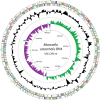Genome analysis of Moraxella catarrhalis strain BBH18, [corrected] a human respiratory tract pathogen
- PMID: 20453089
- PMCID: PMC2897349
- DOI: 10.1128/JB.00121-10
Genome analysis of Moraxella catarrhalis strain BBH18, [corrected] a human respiratory tract pathogen
Erratum in
- J Bacteriol. 2012 Dec;194(24):7021
Abstract
Moraxella catarrhalis is an emerging human-restricted respiratory tract pathogen that is a common cause of childhood otitis media and exacerbations of chronic obstructive pulmonary disease in adults. Here, we report the first completely assembled and annotated genome sequence of an isolate of M. catarrhalis, strain RH4, which originally was isolated from blood of an infected patient. The RH4 genome consists of 1,863,286 nucleotides that form 1,886 protein-encoding genes. Comparison of the RH4 genome to the ATCC 43617 contigs demonstrated that the gene content of both strains is highly conserved. In silico phylogenetic analyses based on both 16S rRNA and multilocus sequence typing revealed that RH4 belongs to the seroresistant lineage. We were able to identify almost the entire repertoire of known M. catarrhalis virulence factors and mapped the members of the biosynthetic pathways for lipooligosaccharide, peptidoglycan, and type IV pili. Reconstruction of the central metabolic pathways suggested that RH4 relies on fatty acid and acetate metabolism, as the genes encoding the enzymes required for the glyoxylate pathway, the tricarboxylic acid cycle, the gluconeogenic pathway, the nonoxidative branch of the pentose phosphate pathway, the beta-oxidation pathway of fatty acids, and acetate metabolism were present. Moreover, pathways important for survival under challenging in vivo conditions, such as the iron-acquisition pathways, nitrogen metabolism, and oxidative stress responses, were identified. Finally, we showed by microarray expression profiling that approximately 88% of the predicted coding sequences are transcribed under in vitro conditions. Overall, these results provide a foundation for future research into the mechanisms of M. catarrhalis pathogenesis and vaccine development.
Figures




References
-
- Aebi, C., B. Stone, M. Beucher, L. D. Cope, I. Maciver, S. E. Thomas, G. H. McCracken, P. F. Sparling, and E. J. Hansen. 1996. Expression of the CopB outer membrane protein by Moraxella catarrhalis is regulated by iron and affects iron acquisition from transferrin and lactoferrin. Infect. Immun. 64:2024-2030. - PMC - PubMed
-
- Bearden, S. W., and R. D. Perry. 1999. The Yfe system of Yersinia pestis transports iron and manganese and is required for full virulence of plague. Mol. Microbiol. 32:403-414. - PubMed
Publication types
MeSH terms
Substances
Associated data
- Actions
- Actions
LinkOut - more resources
Full Text Sources
Other Literature Sources
Molecular Biology Databases

